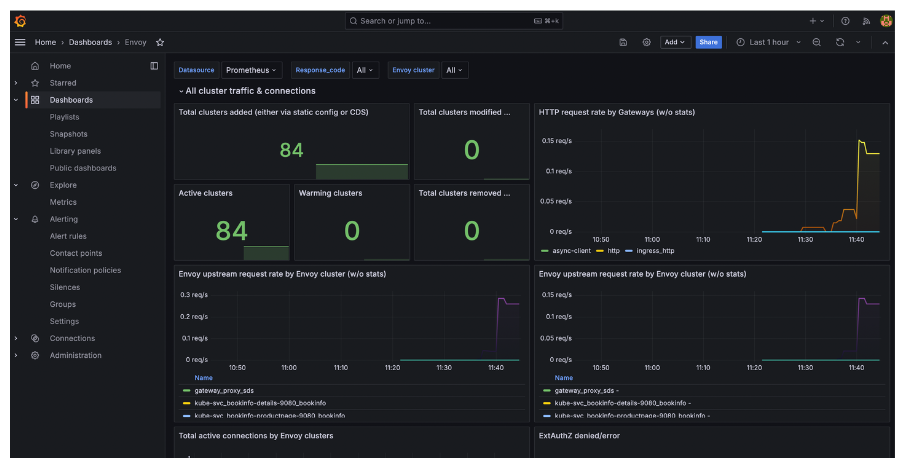Observability
Gain insight into the health and performance of your gateways.
About
Metrics are essential to gain insight into the health and performance of your gateway proxies. OpenTelemetry is a flexible open source framework that provides a set of APIs, libraries, and instrumentation to help capture and export telemetry data, such as metrics. The framework can also be used to collect traces and logs from your apps. Then, you can use observability tools, such as Grafana or Prometheus, to visualize your metrics so that you can analyze the health of your gateway and troubleshoot issues more easily.
In this guide, you deploy an OpenTelemetry collector that scapes metrics from the K8sGateway proxies in the data plane, the K8sGateway pods in the control plane, and the external auth and rate limiting add-ons. The metrics that are collected by the OpenTelemetry collector are exposed in Prometheus format. To visualize these metrics, you also deploy a Grafana instance that scrapes the metrics from the OpenTelemetry collector.
If you do not want to deploy an OpenTelemetry collector and Grafana, you can quickly see the raw Prometheus metrics that are automatically exposed on the gateway proxy by accessing the Prometheus metrics on your gateway.
- Port-forward the gateway deployment on port 19000.
kubectl -n gloo-system port-forward deployment/gloo-proxy-http 19000 - Access the gateway metrics by reviewing the Prometheus statistics.
Before you begin
-
Follow the Get started guide to install K8sGateway, set up a gateway resource, and deploy the httpbin sample app.
-
Get the external address of the gateway and save it in an environment variable.
export INGRESS_GW_ADDRESS=$(kubectl get svc -n gloo-system gloo-proxy-http -o jsonpath="{.status.loadBalancer.ingress[0]['hostname','ip']}") echo $INGRESS_GW_ADDRESSkubectl port-forward deployment/gloo-proxy-http -n gloo-system 8080:8080
Set up an OpenTelemetry collector
-
Add the Helm repository for OpenTelemetry.
helm repo add open-telemetry https://open-telemetry.github.io/opentelemetry-helm-charts helm repo update -
Install the OpenTelemetry collector in your cluster. This command sets up pipelines that scrape metrics from the gateway proxies, K8sGateway control plane, and external auth and rate limiting add-ons, and exposes them in Prometheus format.
helm upgrade --install opentelemetry-collector open-telemetry/opentelemetry-collector \ --version 0.97.1 \ --set mode=deployment \ --set image.repository="otel/opentelemetry-collector-contrib" \ --set command.name="otelcol-contrib" \ --namespace=otel \ --create-namespace \ -f -<<EOF clusterRole: create: true rules: - apiGroups: - '' resources: - 'pods' - 'nodes' verbs: - 'get' - 'list' - 'watch' ports: promexporter: enabled: true containerPort: 9099 servicePort: 9099 protocol: TCP config: receivers: prometheus/gloo-dataplane: config: scrape_configs: # Scrape the K8sGateway proxies - job_name: gloo-gateways honor_labels: true kubernetes_sd_configs: - role: pod relabel_configs: - action: keep regex: kube-gateway source_labels: - __meta_kubernetes_pod_label_gloo - source_labels: [__meta_kubernetes_pod_annotation_prometheus_io_scrape] action: keep regex: true - source_labels: [__meta_kubernetes_pod_annotation_prometheus_io_path] action: replace target_label: __metrics_path__ regex: (.+) - action: replace source_labels: - __meta_kubernetes_pod_ip - __meta_kubernetes_pod_annotation_prometheus_io_port separator: ':' target_label: __address__ - action: labelmap regex: __meta_kubernetes_pod_label_(.+) - source_labels: [__meta_kubernetes_namespace] action: replace target_label: kube_namespace - source_labels: [__meta_kubernetes_pod_name] action: replace target_label: pod prometheus/gloo-controlplane: config: scrape_configs: # Scrape the K8sGateway control plane - job_name: gloo-gateways honor_labels: true kubernetes_sd_configs: - role: pod relabel_configs: - action: keep regex: gloo source_labels: - __meta_kubernetes_pod_label_gloo - source_labels: [__meta_kubernetes_pod_annotation_prometheus_io_scrape] action: keep regex: true - source_labels: [__meta_kubernetes_pod_annotation_prometheus_io_path] action: replace target_label: __metrics_path__ regex: (.+) - action: replace source_labels: - __meta_kubernetes_pod_ip - __meta_kubernetes_pod_annotation_prometheus_io_port separator: ':' target_label: __address__ - action: labelmap regex: __meta_kubernetes_pod_label_(.+) - source_labels: [__meta_kubernetes_namespace] action: replace target_label: kube_namespace - source_labels: [__meta_kubernetes_pod_name] action: replace target_label: pod prometheus/gloo-addons: config: scrape_configs: # Scrape the extauth and ratelimit workloads - job_name: gloo-gateways honor_labels: true kubernetes_sd_configs: - role: pod relabel_configs: - action: keep regex: extauth|rate-limit source_labels: - __meta_kubernetes_pod_label_gloo - source_labels: [__meta_kubernetes_pod_annotation_prometheus_io_scrape] action: keep regex: true - source_labels: [__meta_kubernetes_pod_annotation_prometheus_io_path] action: replace target_label: __metrics_path__ regex: (.+) - action: replace source_labels: - __meta_kubernetes_pod_ip - __meta_kubernetes_pod_annotation_prometheus_io_port separator: ':' target_label: __address__ - action: labelmap regex: __meta_kubernetes_pod_label_(.+) - source_labels: [__meta_kubernetes_namespace] action: replace target_label: kube_namespace - source_labels: [__meta_kubernetes_pod_name] action: replace target_label: pod exporters: prometheus: endpoint: 0.0.0.0:9099 debug: {} service: pipelines: metrics: receivers: [prometheus/gloo-dataplane, prometheus/gloo-controlplane, prometheus/gloo-addons] processors: [batch] exporters: [prometheus] EOF -
Verify that the OpenTelemetry collector pod is running.
kubectl get pods -n otelExample output:
NAME READY STATUS RESTARTS AGE opentelemetry-collector-6d658bf47c-hw6v8 1/1 Running 0 12m
Set up Grafana
-
Deploy Grafana and other Prometheus components in your cluster. The following example uses the kube-prometheus-stack community Helm chart to install these components.
helm repo add prometheus-community https://prometheus-community.github.io/helm-charts helm repo update helm upgrade --install kube-prometheus-stack \ prometheus-community/kube-prometheus-stack \ --version 61.2.0 \ --namespace monitoring \ --create-namespace \ --values - <<EOF alertmanager: enabled: false grafana: service: type: LoadBalancer port: 3000 nodeExporter: enabled: false prometheus: prometheusSpec: ruleSelectorNilUsesHelmValues: false serviceMonitorSelectorNilUsesHelmValues: false podMonitorSelectorNilUsesHelmValues: false EOF -
Verify that the Prometheus stack’s components are up and running.
kubectl get pods -n monitoringExample output:
NAME READY STATUS RESTARTS AGE kube-prometheus-stack-grafana-86844f6b47-frwn9 3/3 Running 0 20s kube-prometheus-stack-kube-state-metrics-7c8d64d446-6cs7m 1/1 Running 0 21s kube-prometheus-stack-operator-75fc8896c7-r7bgk 1/1 Running 0 20s prometheus-kube-prometheus-stack-prometheus-0 2/2 Running 0 17s -
Create a PodMonitor resource to scrape metrics from the OpenTelemetry collector.
kubectl apply -n otel -f- <<EOF apiVersion: monitoring.coreos.com/v1 kind: PodMonitor metadata: name: otel-monitor spec: podMetricsEndpoints: - interval: 30s port: promexporter scheme: http selector: matchLabels: app.kubernetes.io/name: opentelemetry-collector EOF -
Save the sample Grafana dashboard configuration as
envoy.json. -
Import the Grafana dashboard.
kubectl -n monitoring create cm envoy-dashboard \ --from-file=envoy.json kubectl label -n monitoring cm envoy-dashboard grafana_dashboard=1
Visualize metrics in Grafana
-
Generate traffic for the httpbin app.
for i in {1..5}; do curl -v http://$INGRESS_GW_ADDRESS:8080/headers -H "host: www.example.com:8080"; done -
Open Grafana and log in to Grafana by using the username
adminand passwordprom-operator.open "http://$(kubectl -n monitoring get svc kube-prometheus-stack-grafana -o jsonpath="{.status.loadBalancer.ingress[0]['hostname','ip']}"):3000"kubectl port-forward deployment/kube-prometheus-stack-grafana -n monitoring 3000 -
Go to Dashboards > Envoy to open the dashboard that you imported. Verify that you see the traffic that you generated for the httpbin app.

Cleanup
You can remove the resources that you created in this guide.-
Remove the configmap for the Envoy dashboard.
kubectl delete cm envoy-dashboard -n monitoring -
Remove the PodMonitor.
kubectl delete podmonitor otel-monitor -n otel -
Uninstall Grafana.
helm uninstall kube-prometheus-stack -n monitoring -
Uninstall the OpenTelemetry collector.
helm uninstall opentelemetry-collector -n otel -
Remove the
monitoringandotelnamespaces.kubectl delete namespace monitoring otel